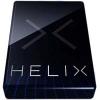Leaderboard
Popular Content
Showing content with the highest reputation on 07/28/2020 in all areas
-
Hi Vorak, You can definitely get high gain sounds on LT, you'll just need to decide which amps work best for your applications. in case this is helpful: Chemical X was a Marshall SLP with the Bradshaw gain boost (AKA "Dookie") Mod. You could try putting a boost in front of a Brit Plexi and adjust from there? Lunatic was an alternative to Insane, a bit of a happy accident. Insane based on the POD 1.0 Recto with gain added Some amps that you may like that didn't exist on the previous products are Revv Gen Red & Archetype Lead. Line 6 Badonk is an update of Big Bottom, which was a manipulated Triple Recto. Hope this helps!2 points
-
Hi Cristt, When set to pre-cab/IR; this feature is beneficial when the user doesn't have an amp with an effects loop and works well when setting the amp to its cleanest setting. If you do have an 'effects loop/power-amp in' then I recommend sending the AMP OUT signal to this input. When doing either the above, you can also switch out the complete amp model in the preset to just the Pre-Amp so you don't add any 'color' of the modeled power amp to your traditional amp.1 point
-
1 point
-
Hey, thanks for the reply. That does make more sense now. I guess I've got used to using dual delays and using note values rather than % of the 1st delay (1/4 note, dotted eighth etc). Will need my calculator now:)1 point
-
1 point
-
I agree it can be confusing, but once you understand how it works, it also can be a benefit (not being limited to mono in between signal splits & merges). It'd be really nice if L6 added a feature that somehow indicates for each segment of the signal path whether it is stereo or mono, maybe by color-coding the path lines, or somehow displaying them differently for mono vs stereo (dashed vs. solid line? single line vs. double line?)1 point
-
Another way to have minimal impact on the tonal character of the preset is to use one of the less over the top overdrives like the Teemah or an even simpler model like the 'Scream 808'. Crank up the volume on the overdrive with the drive turned down to zero,then slowly bring the drive up, leaving it on a relatively low setting. This method can deliver overdrive with minimal coloration to the tone.1 point
-
Companies don't have unlimited resources when it comes to R&D. In an innovative company, their reach will always exceed their grasp. So it all comes down to prioritizing things. That's really why Ideascale is helpful to Line 6. It gives them a better idea of what demand is actually like for various features. With other online forums and social media, it's possible for small number of people to make a lot of noise about certain features... Sometimes that works, and sometimes it doesn't. I think people would be surprised if they actually saw the size of the teams Line 6 has working on the various product lines. They get a lot done, really. We also never know what's happening behind the scenes as far as people taking other jobs, etc. There have been a good number of Line 6 engineers poached by Apple over the years...1 point
-
Hi, I just wanted to post a thread that explains the actual reason why FRFR, PA, and studio monitor speakers typically still require treble cut to avoid sounding fizzy with distortion or overdrive on a guitar tone. THE COMMON PROBLEM I've read through some of the threads on this topic, and while I saw one person post the correct explanation (Without getting the credit or kudos he deserved for it, from what I saw), most people state the problem is that the user is not understanding the difference between guitar speakers and FRFR speakers. I believe users aren't that naive - and many good comparisons exist where users get great sound from helix (without virtual cab) into power amp into real cab, or other ... simpler..... modeller brand (with only virtual cab) directly into FRFR. However most of those "it's simple - guitar speakers have less treble, so you need to cut treble on FRFR" explanations go on to incorrectly state that the problem is that guitar cabs cut the treble a lot because they aren't flat, where as FRFR speakers are, at least in theory, outputting a flat response - therefore putting out much more volume at high frequencies than guitar cabs do. I mean, yes, that is true ... but NO that is not the problem. Again, the scenario is that we ALREADY have a virtual cab or IR in our signal chain - so shouldn't the high frequencies already be cut? Shouldn't the FRFR speaker just output exactly what that virtual cab sounds like, with the already good sounding treble cut baked into the virtual cab since it's a copy of a real cab??? (The end user, and you here, are asking this.... :-) ) Folks state that you need to think like a recording or mixing engineer, not like a guitarist - which is absolutely correct. But stating that with FRFR speakers you need to cut treble because it is brighter than a guitar cab is not logical, nor correct, since the scenarios being discussed invariably have either a virtual guitar cab already in the signal chain, or a cab IR. Since we have a virtual cab in a block, we already HAVE that high cut, so the statement is not correct - not in the simple way most folks tell it on this forum, at least. There is more to it.... The common problem from nearly everybody using a helix is with the end users who are experiencing fizz through FRFR, and questioning why, considering they are using a virtual cab or cab IR which is emulating the sound of the cab. WHAT A VIRTUAL CAB OR IR IS ACTUALLY REPRODUCING The simple description of the problem is that it's NOT emulating the sound of the cab FROM a position that a guitarist would be playing and listening to the tone. The facts of why the virtual cab, or many of the cab IRs available, are NOT sufficient to sound like a cab in a room are with how the virtual cab or cab IR were miked up: - In a virtual cab, and in many cab IRS, the cab was, more or less, close miked, in one mix position, on one part of one cone. That is how many cabs are miked in the studio and live... but is NOT how you get the sound you hear as a guitarist when playing through your amp. IT IS a MUCH brighter tone, and much LESS COMPLEX than the sound of a real cab in a room. The virtual cabs or many of the cab IRs are miked this way for various reasons - technical reasons (CAB IR files aren't really designed to handle the long recording of room reflections and short plate reverb that your cab in a room would require)..... and removing early reflections as much as possible by close miking in a dead room allows you, the player, to configure the rest of the tone after the close miked speaker on the cab - you can eq to mimick various rooms, you can add room or plate verb for the same reason.... etc. You might think... "Ok, so because the guitar cab is close miked, it is much brighter and fizzier, right? like how if I put my ear to it and play quietly with a distortion pedal, it sounds bad.... that's your point? So Why can't I just put my FRFR speaker where my guitar cab would normally go and play and have it sound the same, since it's playing back the exact sound of a guitar speaker in that location, and the room and angle should take care of everything else?" Well, folks, that is an EXCELLENT grasp on the close miked speaker sound, yes it's much brighter and fizzier, but it is missing a couple of important points about the "amp in the room" sound when playing through an FRFR or PA. 1) the FRFR or PA probably has FAR better high frequency dispersion than your guitar speaker, up high, and you always hear the on axis tone (IE: the virtual cab sounds like a close miked speaker, so you get that sound everwhere in front of the FRFR without it changing with direction or distance in the way a real guitar cab does). So where every you stand, relative to your FRFR speaker, it's like having your guitar cab aimed right at, and next to, your ears. 2) the close miked virtual cab response or IR response is on one part of the cone and miked from one direction... it is one aspect of the tone. Dust cap, edge, OR middle of cone, on axis OR off axis, at a specific distance. 3) No matter how bright each guitar speaker on it's own sounds, in a cab with more than one speaker there remains much less high frequency sound once you're a certain distance away from it - due to physics of how multiple speaker outputs work together for dispersion, etc. The real sound from the cab as you hear it is a mix of many radically different tones coming from various parts of the guitar speaker. Guitar speakers are not rigid cones, normally, and the dust cap, edge, middle of the cone, and other areas can truly sound quite different, as can on axis versus off axis tones. This is why some of the best CAB IR libraries include multi miked files... it's sort of a pre-mixed cab IR that actually sound sound much more like the blend you get from a real cab when you play back through an FRFR or PA. A guitar cab with more than one speaker is extra difficult to reproduce when single miked as a cab IR or virtual cab - because the tone in the room is a wild, chaotic mix of the multitude of EQs and tones you get from the cab, all interestingly blended together. So, a MIX engineer in a studio will be accustomed to taking that fizzy close miked amp recording and EQing it accordingly to make it sound great through studio monitors, which are truly FRFR (and likely the only TRULY FRFR speakers you will ever encounter, since they are typically EQed to be as neutral, or flat as possible, in that control room. AT least ONE set of their monitors should be like that, anyhow, in a big studio. They probably mix on something like NS7s though, or other similarly bright and revealing speakers, which also reminds the engineer to cut back on high frequencies and remove the fizz. So yes, think like an engineer, but for the right reasons, and with a little tiny bit more of the full picture than you had before. Saying that guitar cabs aren't as bright as FRFR as a reason to cut treble is simply wrong, since we all know we're placing a virtual guitar cab that, one would ASSUME, must have that same high cut in our signal path. It's actually because our virtual cabs, and some cab IRs, contain much more high frequencies than you actually hear from the real cab when standing and playing... and an FRFR or PA speaker will not result in the same high cut in a room as the actual cab would, due to physical design differences between the transducers and the layout of the speakers. Basically, the original cab IR or virtual cab was probably not setup as a mic in a room standing where a guitarist stands while playing.... it is probably a MUCH brighter recording that isn't anything like how you normally hear your cab... but is great for a studio MIX engineer to work with. SO YOU STILL NEED TREBLE CUT, EVEN WITH A VIRTUAL CAB, or with MANY IRs (but maybe not all IRs) Rest assured - if you have a virtual cab, you still need treble cut (at the very least) after a helix virtual cab or many of the cab IRs you can buy to sound anything like a real cab when you connect your helix directly to a TRUE FRFR cab or to a PA... and honestly you probably need a bit of plate reverb and possibly some low end cut also to really get you there. But what DOES a virtual cab or cab IR do for you? it gets you the true EQ of that cab, in a common, popular recorded microphone position for studio use. Just cut 8kHz, more or less, and up from there, ... probably rather dramatically, and it will start to sound similar to a good cab.....but use your ears, choose eq how you like it. Or, look for an IR library that is a producer blend of mic positions and /or room sound in one cab IR - and you will probably find that you love that sound. Another minor footnote - FRFR cabs you can buy for modelers are not particularly flat response or full range, but they are MUCH more so than most guitar cabs. A PA is often hotter in the highs than a real FRFR speaker is. A REAL FRFR can likely only be found in some recording studios, and even then might not be the speakers chosen by the engineer to work with... for reasons I won't get into here.1 point
-
An active ABY will sometimes do this. I have a Morley ABY that does it. A ground loop will do this. Make sure the Amp, HXS and anything else connected are all on the same EMI/RFI filtered power strip and that there's no fluorescents or appliances on that wall circuit. If there's no ground switch on the PA, same applies. Don't forget any USB devices, computers etc. You may have the send/returns set to LINE when they want INSTRUMENT. Check Global>Ins/Outs. Use shielded (instrument) cables on the Send/Returns. Failing all that, swap out some cables. If you've STILL got noise, call the local witch/wizard to check for proximity to major ley lines......1 point
-
1 point
-
1 point
-
1 point
-
Not surprised, seemed like normal behavior. Sorry I have not been able to recreate the bug you are seeing yet. A little off topic but I wanted to point out this observation which I made while trying to recreate your bug. You may have already noticed this but If you assign an alternate tuning for the Variax on the Helix it is only invoked when you switch to that preset. If you change the tuning knob on the Variax, changing snapshots will not retrieve your alternate tuning setting on the Helix. However, if you assign the alternate tuning settings parameter to a snapshot , e.g. 'Preset Variax String 6 '= [-2(D)] then when you switch snapshots it will invoke your alternate tuning setting from the Helix again. This actually makes a lot of sense and seems like it would be the preferred behavior. To sum up, default behavior is that the alternate tuning setting on the Helix is only invoked on a preset switch unless the tuning is assigned to a snapshot in which case it will invoke it when you switch to the preset and also every time the snapshot is changed. This means that if you assign the tuning to a snapshot you can change the tuning knob on the Variax in between snapshots and still get back to the alternate tuning setting on the Helix preset by switching to another snapshot or even just stomping on the current snapshot again. You don't have to switch away and back to the preset. I suppose this behavior might be useful for some songs. Seems well thought out and I like the way it works. The described switching behavior may seem like belaboring the obvious but it is unique to using the Variax with the Helix and seemed worth mentioning. Of course, as you would expect, it generally would make more sense to just assign different tunings to your snapshots and never change the Variax tuning knob manually. I will post back if I run into the issue you are seeing.1 point
-
you should get a decent sound just plugging in without any podfarm/gearboxx stuff. 1. get the bass plugged in 2. deselect AMPS.....get the volume right, tone....if ok proceed, if not look at cables, guitar itself etc.. 3. if sound is ok, then select the instrument in for the bass and go through the bass amps....if you dont like those, maybe just try the Dynamics like the LA2A and a Noise Gate etc..... if you cant get a good sound there maybe try a regular guitar amp, get creative. if you cant find a tone somethings probably really wrong with your monitoring chain? you shouldnt need anything but the UX unit to get a good bass sound. yuou ask....How do you get a good bass sound? ********************************** 1. plug the bass into instrument input 1 with a good guitar cable, have all guitar knobs on full blast (not a speaker cable only use a instrument cable) 2. open PodFarm and select instrument 1 in the L6 software and select BASS AMPS 3. find a choice amp 4. add the LA2A in front of the BASS AMP....maybe Gate if needed for my single coil pickup noise Tweak to pleasure then SAVE AS...." bass amp" and its there.1 point
-
I use reverb (old school) on almost every patch, and delay is used on leads and such. I have no bias against those that dont and im against reverb racism and delay deplorables. :P1 point
-
This is an italian guitar player in a normal gig, no super stage. Only a small gig in outside a pub or a restaurant i don't know, but it's something that you could do too. Do you like his sound? no amp only Helix and Yamaha dbr 12 monitors. I think is a great sound. If He can do it...you can do it. https://www.youtube.com/watch?v=cXPHnJh7R8Y1 point
This leaderboard is set to Indiana - Indianapolis/GMT-04:00







